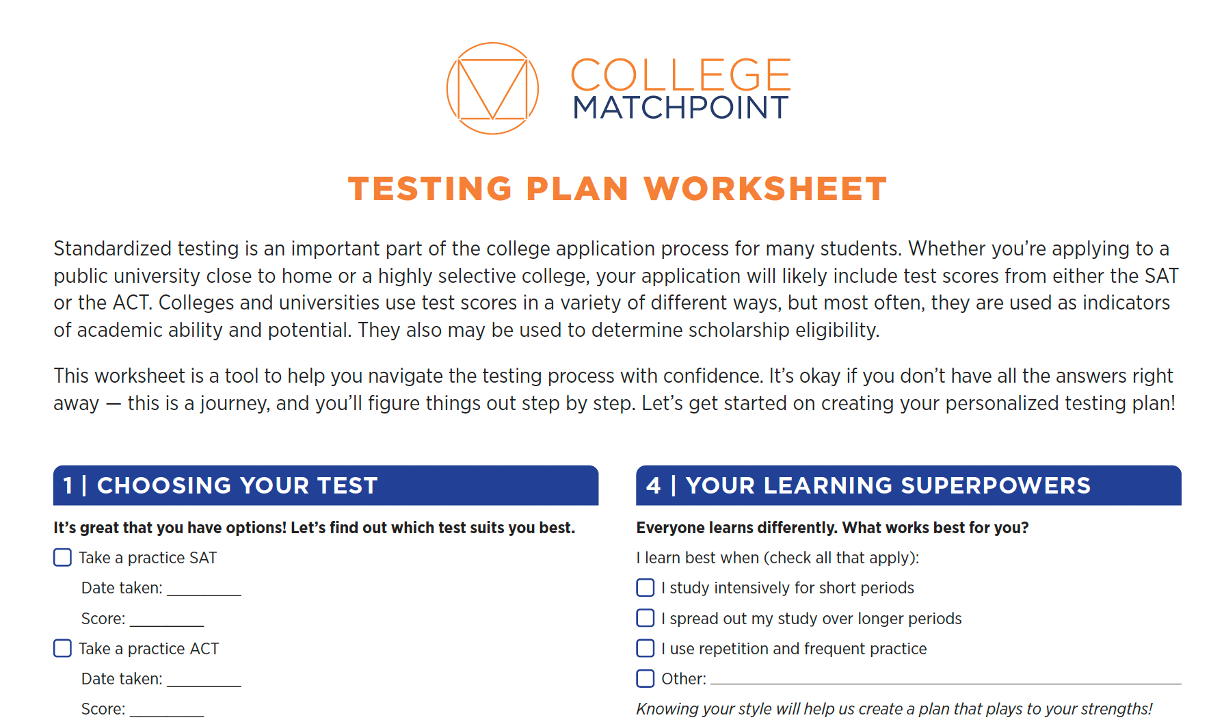This page is licensed under Creative Commons under Attribution 4.0 International. Anyone can share content from this page, with attribution and link to College MatchPoint requested.
Busting the Top 5 Myths About SAT/ACT in 2024: What Parents Need to Know Now
As we enter another year of college admissions, the landscape of standardized testing continues to evolve. With recent changes to both the SAT and ACT, as well as shifting college policies, it's more important than ever for students and parents to stay informed. In this post, we'll explore one big reality about standardized testing in 2024 and debunk five common myths to help you navigate this crucial aspect of college applications.

The One Big Reality: You Need a Plan
The overarching truth about standardized testing for college admissions in 2024 is simple: you need a plan. With evolving test formats, shifting college policies, and a landscape that varies from school to school, a one-size-fits-all approach simply doesn't cut it anymore.
Your testing plan should be as unique as your college list. It needs to consider your academic strengths, target schools' preferences, and your overall application strategy. Are you applying to test-optional schools where a strong score could set you apart? Or to colleges that still require scores? Maybe you're looking at schools with different policies for different majors?
A solid plan also accounts for your personal circumstances. When will you have time to prepare? How many times can you realistically take the tests? What resources do you have for preparation? By thinking through these questions early, you can avoid last-minute scrambles and make informed decisions about when and how to approach standardized testing.
Remember, a good plan is flexible. As you progress through your junior and senior years, you may need to adjust based on your initial scores, changes in college policies, or shifts in your college list. The key is to start thinking strategically about testing now, so you're prepared for whatever comes your way.
With this reality in mind, let's dive into some common myths about standardized testing that might be influencing your planning process.
5 Myths About Standardized Testing in 2024
Myth #1: All schools are still test-optional
While many colleges adopted test-optional policies during the pandemic, we're seeing a shift back to test requirements at some institutions. Notable examples include Dartmouth College, Brown University, and the University of Texas at Austin, all of which have returned to requiring test scores for admissions. This trend underscores the importance of staying informed about the specific requirements of each school on your list, as policies can and do change.
In this insightful webinar, our seasoned test prep expert, Jed Applerouth, Ph.D., dove deep into the shifting landscape of standardized testing. Discover the latest trends and understand how these changes affect high school students today. Learn how to create a personalized testing plan and explore test-optional strategies to boost your college admissions success.
Myth #2: Test-optional means test scores don't matter
Even at schools that remain test-optional, submitting strong test scores can often provide an advantage. At highly selective schools, students who submit test scores often have higher admission rates. For example, at Yale, applicants who submitted test scores were admitted at about three times the rate of those who didn't. Don't assume "optional" means "unnecessary" - if you can achieve a competitive score, it's usually worth submitting.
Myth #3: The SAT and ACT are basically the same test
While there are similarities, these tests have distinct differences. The SAT tends to have more advanced math and higher-level reading passages, while the ACT includes a science section and generally requires faster processing speed. It's worth taking a practice test of each to see which format suits you better.
Myth #4: The digital SAT/ACT are completely different from the paper versions
While the format has changed, the core content and skills tested remain largely the same. The digital versions offer some advantages, like an on-screen calculator and more generous timing. Don't be intimidated by the new format - with some practice, most students adapt quickly.
Myth #5: The new digital tests disadvantage neurodiverse students
Contrary to this belief, the new digital SAT and ACT actually offer several features that can benefit neurodiverse students. The shorter test length reduces fatigue and attention demands. Built-in tools like text-to-speech and adjustable font sizes support students with reading difficulties. The ability to flag questions for review helps with time management. Additionally, the adaptive nature of the tests means students are more likely to see questions appropriate to their skill level, potentially reducing anxiety. While every student's needs are unique, many aspects of the digital format align well with accommodations that have traditionally supported neurodiverse learners.
Remember, the goal of standardized testing is to showcase your academic strengths as part of a holistic college application. Stay focused on your personal goals, seek support when needed, and approach the process with a balanced perspective. With the right information, preparation, and plan, you can navigate the world of standardized testing with confidence and success.

This detailed worksheet is crafted to help students navigate the complexities of preparing for standardized tests like the SAT and ACT. It guides students in selecting the test that best suits their strengths by comparing practice test results and considering their academic progress. The tool also supports the creation of a personalized study schedule that accommodates each student's unique learning style and extracurricular commitments. It encourages students to set realistic score goals and track their progress over time, making adjustments as needed. By considering factors like accommodations and the testing ranges of dream schools, the tool ensures a tailored and strategic approach to test preparation.


